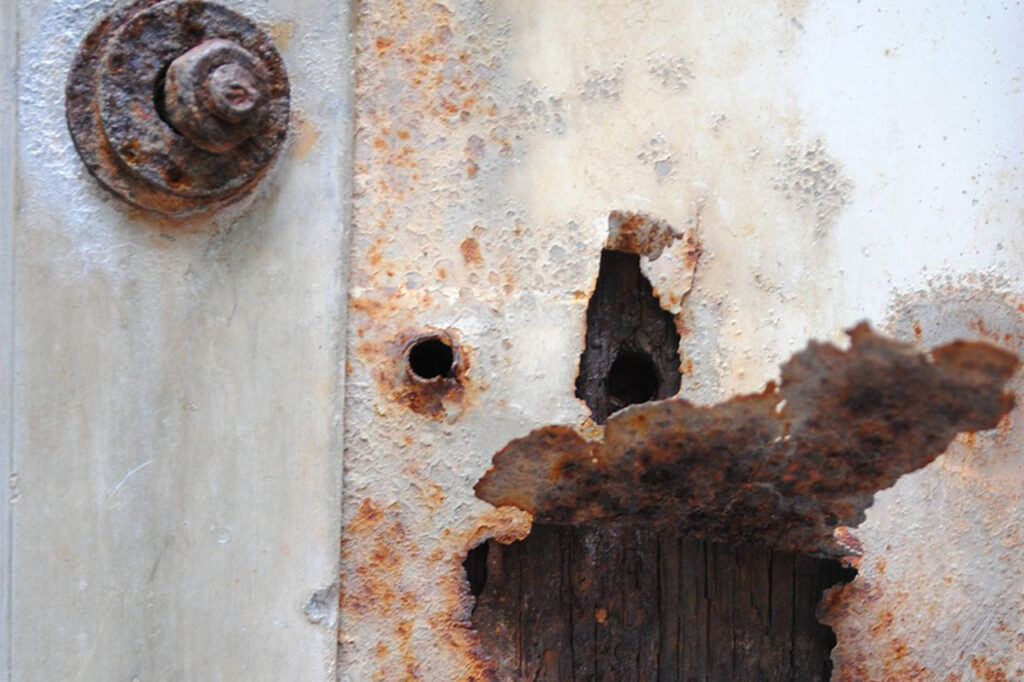If the Man of Steel has one weakness (kryptonite), then does steel have a kryptonite?
While we look at steel as a durable material, it is certainly not invulnerable. We call it rust, and we should protect our steel structures from these enemies at all cost. It would literally harm our investment.
In this article, the folks at Lion Buildings will discuss how you can prevent rust from eating away at our metal buildings.
Understanding the Nature of Rust
Rust is the natural enemy of metal structures. It starts when iron or steel interacts with oxygen and moisture, triggering a chemical process known as oxidation. As this reaction progresses, it causes the metal to deteriorate, weakening its structure and reducing its lifespan. For metal buildings that are constantly exposed to weather elements like rain, snow, and high humidity, the risk of rust is continuous. Over time, if not addressed early, rust can compromise the safety and stability of the entire structure. This is why recognizing the causes and early signs of rust is essential for maintaining any metal building.
When metal is left unprotected in environments that include moisture, air, and sometimes pollutants, the iron content in steel begins to form iron oxide. This reddish-brown compound, commonly known as rust, does not adhere well to the surface of the metal. Instead, it flakes off, revealing a fresh layer of metal that begins to rust all over again. This creates a cycle that can be hard to stop once it starts. The more surface area exposed, the faster rust can take hold. This makes it especially important to address even the smallest patches of rust before they spread.
Certain parts of a metal building are more prone to rusting than others. Joints and seams, where panels connect, are common trouble spots because moisture can seep into these tight spaces and linger. Fasteners like bolts and screws, particularly if not treated or coated for corrosion resistance, are also vulnerable.
Flat surfaces where water might pool after rain or areas where snow and ice accumulate pose significant risks. Prolonged exposure in these zones accelerates the oxidation process, leading to severe damage unless preventive measures are implemented.
Design Considerations to Minimize Rust
Prevention begins with design. A well-designed metal building incorporates elements that limit water exposure and improve drainage. Roofs with appropriate slope allow rainwater to run off rather than pool. Gutters and downspouts help direct water away from walls and foundations. Roof overhangs and awnings provide additional protection against precipitation.
Ventilation is another critical factor. Trapped moisture inside a building can accelerate rust formation, especially in poorly ventilated areas like corners and enclosed spaces. Ridge vents, gable vents, or mechanical systems promote airflow and reduce humidity levels.
Proper site preparation also contributes to rust prevention. Elevating the building foundation prevents contact with groundwater, while grading the landscape around the building ensures proper drainage. These proactive steps create a less hospitable environment for rust to develop.
Choosing the Right Materials
Selecting corrosion-resistant materials can drastically reduce the risk of rust. Galvanized steel is coated with a layer of zinc that protects the metal beneath. This sacrificial layer corrodes first, sparing the steel and significantly extending the lifespan of the building. Galvalume, which combines aluminum, zinc, and silicon, offers even greater resistance and is a popular choice for metal roofing and siding.
Stainless steel contains chromium, which forms a passive film on the surface that resists oxidation. Though more expensive, it is ideal for highly corrosive environments such as coastal areas or buildings near industrial pollutants.
Fasteners are often overlooked, but they are critical in rust prevention. Using zinc-coated or stainless-steel screws and bolts ensures that the smallest components are protected. Inferior fasteners can become the weak point in an otherwise well-protected structure.
Protective Coatings and Paints
Coatings are one of the most effective defenses against rust. Paint provides a physical barrier between the metal and the environment. Specialized metal paints contain rust-inhibiting compounds that enhance durability. Before application, surfaces should be cleaned of dirt, oil, and previous corrosion to ensure proper adhesion.
Primer is essential. It not only helps the topcoat adhere better but also contains ingredients designed to resist rust. Acrylic and epoxy-based primers are widely used in industrial applications due to their strength and longevity.
Powder coating offers an even more robust solution. Applied as a dry powder and then cured under heat, this finish bonds tightly to the metal and resists chipping, scratching, and moisture intrusion. While more costly than paint, powder coating is an excellent investment for long-term protection.
Routine Maintenance Practices
Regular maintenance plays a crucial role in rust prevention. Begin with frequent inspections, especially after storms or seasonal changes. Look for signs of water damage, chipped paint, or rust spots. Catching these early can prevent more extensive and expensive repairs later.
Cleaning your building helps maintain its integrity. Removing dirt, leaves, and other debris keeps water from collecting in unwanted places. Pay special attention to roof valleys, gutters, and areas around windows and doors.
Touching up paint chips immediately can stop rust before it starts. Keep extra paint and primer on hand for these small but essential repairs. For buildings in particularly humid or rainy climates, scheduling a professional inspection once or twice a year is a wise choice.
Moisture Control and Environmental Management
Controlling the environment around your metal building can dramatically reduce rust risk. Begin with landscaping. Keep bushes and trees trimmed away from walls to allow air circulation and prevent moisture buildup. Avoid stacking materials like wood or soil against metal walls.
Inside the building, use dehumidifiers to maintain proper humidity levels. This is especially important for buildings that house equipment, inventory, or animals. Installing vapor barriers under insulation can also limit moisture intrusion.
Buildings located near saltwater or industrial zones face higher corrosion risks due to airborne salts and chemicals. In these cases, choose higher-grade materials and consider more frequent washing to remove contaminants.
Repairing Rust Damage
When rust does appear, immediate action is needed. Begin by removing the rust with a wire brush, sandpaper, or a grinder. Ensure all the loose and flaky material is cleared away. Wash the area thoroughly and let it dry.
Once clean, apply a rust converter. This chemical treatment transforms rust into a stable compound that can be painted over. Follow this with a rust-inhibiting primer and finish with high-quality metal paint. In severe cases, panels or components may need to be replaced.
Do not ignore rust. Small spots can quickly evolve into structural weaknesses. A proactive approach to rust repair extends the life of your building and prevents larger financial burdens.
Investing in Rust Prevention Saves Money
Preventing rust is not just about maintaining appearances. It protects your investment. A rust-free building retains its structural strength, maintains its property value, and ensures the safety of its contents and occupants. Prevention costs a fraction of repair or replacement expenses.
Insurance providers may also look favorably on well-maintained buildings, potentially leading to lower premiums. Buyers and tenants are more likely to choose properties that show signs of good upkeep.
In industrial or agricultural settings, equipment and materials stored in a rusted building can suffer damage, leading to operational disruptions and loss of productivity. Preventive maintenance safeguards not only the building but also everything inside it.
Conclusion
Rust is a manageable threat to metal buildings if addressed from the beginning. Smart design, quality materials, protective coatings, and regular upkeep form the foundation of rust prevention. Attention to environmental factors and timely repairs further protect your structure.
Creating a plan that includes inspection schedules, maintenance routines, and emergency repair strategies allows you to stay ahead of corrosion. A rust-free metal building is a symbol of foresight, responsibility, and long-term value. Investing in rust prevention today ensures that your building stands strong and serves its purpose for decades to come.

